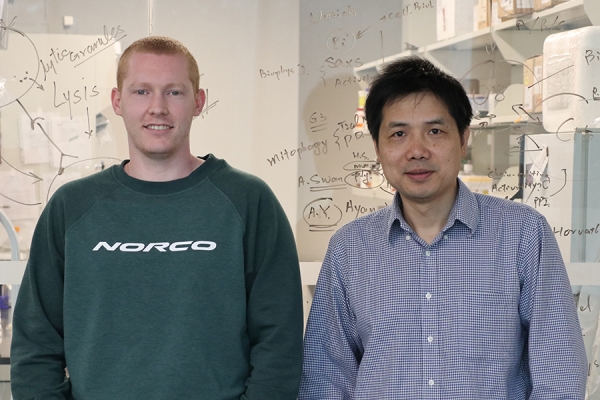 Doctoral student Cody Caba and biochemistry professor Yufeng Tong are pursuing a possible line of inquiry to prevent and treat Parkinson’s disease.
Doctoral student Cody Caba and biochemistry professor Yufeng Tong are pursuing a possible line of inquiry to prevent and treat Parkinson’s disease.
UWindsor researchers are studying two enzymes to determine their role in Parkinson’s disease and whether they hold the key to neuronal health.
“As occurrences of Parkinson’s are predicted to double in the next 20 years, there is a critical need for the development of prophylactic and therapeutic interventions,” says Yufeng Tong, chemistry and biochemistry professor.
Parkinson’s disease is a movement disorder characterized by progressive neurodegeneration and a breakdown of communication between the brain and body.
It affects one in every 500 people in Canada and poses a major socioeconomic burden to society, families, and caregivers. It is the world’s fastest-growing neurological disease, and the incidence rate increases significantly with age; individuals over 85 years old are almost 200 times more likely to be impacted by Parkinson’s disease than those 40 to 44 years of age.
“We have recently identified two enzymes, USP8 and AMPK, that interact and may be involved in mechanisms that lead to the onset and progression of Parkinson’s,” says Dr. Tong.
Determining whether these enzymes or proteins are truly involved could help pharmaceutical companies find treatments by developing drugs targeting them.
“What we are characterizing right now is the novel interaction between USP8 and AMPK, something that has not been seen previously,” says Cody Caba, PhD student in Tong’s research lab.
“The main takeaway is that the interaction between these proteins bridges the activity of USP8 with cellular metabolism — because AMPK is a big player in general metabolism — and there’s a building idea as to its role in pathways that can lead to Parkinson’s disease, should they become dysregulated.”
The project is part of a $25,000 Mitacs Accelerate grant, in collaboration with the Parkinson's Society Southwestern Ontario, for a project called, “Regulation of ubiquitin specific protease 8 by AMPK-mediated phosphorylation.”
“Our goal is to characterize how these enzymes function in normal and disease conditions,” Caba says.
What is currently known is AMPK modifies USP8 through a process called phosphorylation. Should this interaction be confirmed, it may pose a novel avenue for treatment of Parkinson’s disease and others, including cancer and a rare disorder known as Cushing’s disease.
“When AMPK phosphorylates USP8, we find that it reduces the level of activity of USP8… this is likely important for cellular homeostasis,” says Caba.
“But when that interaction is disrupted and the activity of USP8 is too high, we believe that activity might be related to some pathophysiological pathways that contribute to Parkinson’s disease.”
The team will explore the interaction of USP8 and AMPK to determine if they are directly involved in Parkinson’s or associated cellular mechanisms.
“The research proposed will add to the growing list of potential therapeutic targets for the fight against this debilitating disease,” says Tong.
